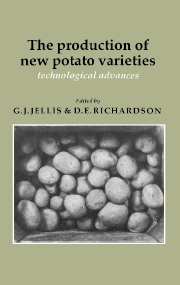Book contents
- Frontmatter
- Contents
- List of contributors
- Preface
- Editors' note and acknowledgements
- Introduction
- The development of potato varieties in Europe
- Genetic Resources
- Breeding Strategies
- Potato breeding strategy in the German Democratic Republic
- Potato breeding strategy in the Federal Republic of Germany
- Potato breeding strategy in the Netherlands
- Potato breeding strategy in Poland
- Potato breeding strategy in the United Kingdom
- Private potato breeding in the United Kingdom
- Selection and Screening Methods
- Variety Assessment
- Semi-conventional Breeding Methods
- True Potato Seed
- Unconventional Breeding Methods
- Commentary
- Index
Potato breeding strategy in the United Kingdom
Published online by Cambridge University Press: 05 March 2012
- Frontmatter
- Contents
- List of contributors
- Preface
- Editors' note and acknowledgements
- Introduction
- The development of potato varieties in Europe
- Genetic Resources
- Breeding Strategies
- Potato breeding strategy in the German Democratic Republic
- Potato breeding strategy in the Federal Republic of Germany
- Potato breeding strategy in the Netherlands
- Potato breeding strategy in Poland
- Potato breeding strategy in the United Kingdom
- Private potato breeding in the United Kingdom
- Selection and Screening Methods
- Variety Assessment
- Semi-conventional Breeding Methods
- True Potato Seed
- Unconventional Breeding Methods
- Commentary
- Index
Summary
INTRODUCTION: HISTORICAL BACKGROUND
At the turn of this century, potato cultivars were produced by interested farmers and enthusiastic amateurs. If a common breeding strategy could be perceived, it was to replace existing cultivars, whose stocks had “degenerated” during the normal course of vegetative reproduction over a number of years in agriculture (Robb 1921, 1948). As with other crop species, potato breeding gained impetus with the increase in understanding of the science of heredity and the rediscovery of Mendel's laws of inheritance. With potatoes, in particular, the practical implications of the discovery that some clones were immune to wart disease (Synchytrium endobioticum), and that this was a heritable trait, provided added impetus. In Scotland, for example, in the 1920s a group of farmers and merchants founded the Scottish Society for Research in Plant Breeding (SSRPB). In cooperation with the Department of Agriculture and Fisheries for Scotland (DAFS), the SSRPB set up what became the Scottish Plant Breeding Station and is now part of the Scottish Crop Research Institute (SCRI) (Gallie 1955; Simmonds 1968). Over the next half century, state support for this and other similar ventures increased and private sector involvement declined in proportion. Lack of legal protection for the breeders of cultivars contributed to a situation where plant breeding in general, and potato breeding in particular, became almost entirely a state funded activity. The situation is now changing and private sector involvement in plant breeding has increased substantially since the introduction of plant variety protection legislation.
- Type
- Chapter
- Information
- The Production of New Potato VarietiesTechnological Advances, pp. 60 - 67Publisher: Cambridge University PressPrint publication year: 1987
- 3
- Cited by

